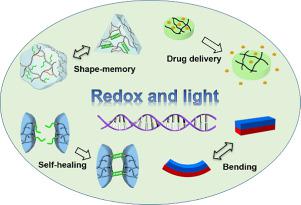Reactive & Functional Polymers ( IF 4.5 ) Pub Date : 2021-07-18 , DOI: 10.1016/j.reactfunctpolym.2021.104983 Chen Wang 1 , Bilha Willner 1 , Itamar Willner 1

|
The synthesis and applications of redox-responsive and photoresponsive hydrogels are introduced. One approach to synthesize redox-responsive hydrogels involves the crosslinking of polymers with nucleic acid duplexes and metal-carboxylate bridges. The second approach to assemble redox-responsive hydrogels includes the cooperative crosslinking of the polymers with duplex nucleic acids and donor-acceptor redox-active bridges. By reversible oxidation/reduction of the redox-active groups, switchable stiffness of the hydrogels is demonstrated. The use of redox-responsive hydrogels as shape-memory and self-healing materials is discussed. Photoresponsive hydrogels are introduced by the design of polymer matrices cooperatively stabilized by permanent crosslinking units, e.g. boronate ester/glucosamine, and trans/cis-photoisomerizable nucleic acid bridges. Alternatively, photoresponsive hydrogels crosslinked by nucleic acids and supramolecular complexes consisted of photoisomerizable host-guest or donor-acceptor complexes are introduced. Cyclic photoinduced formation/dissociation of the photoresponsive bridges lead to reversible stiffness of the hydrogels. In addition, Au nanoparticles (NPs) or nanorods (NRs) are immobilized in hydrogels. The light-induced thermoplasmonic melting of the nucleic acid bridges by Au NPs or NRs and switchable stiffness of the hydrogels are demonstrated. The stiffness-controlled hydrogels are applied as shape-memory and self-healing matrices and as controlled drug release materials. In addition, light-induced mechanical bending of bilayer hydrogels consisting of Au NPs/NRs is demonstrated.
中文翻译:

氧化还原响应和光响应 DNA 基水凝胶及其应用
介绍了氧化还原响应和光响应水凝胶的合成和应用。合成氧化还原响应水凝胶的一种方法涉及聚合物与核酸双链体和金属-羧酸桥的交联。组装氧化还原响应水凝胶的第二种方法包括聚合物与双链核酸和供体-受体氧化还原活性桥的协同交联。通过氧化还原活性基团的可逆氧化/还原,证明了水凝胶的可切换刚度。讨论了氧化还原响应水凝胶作为形状记忆和自修复材料的用途。光响应水凝胶是通过设计由永久交联单元(例如硼酸酯/葡糖胺)和反式/顺式光异构化核酸桥。或者,引入由核酸交联的光响应水凝胶和由可光异构的宿主-客体或供体-受体复合物组成的超分子复合物。光响应桥的循环光诱导形成/解离导致水凝胶的可逆刚度。此外,金纳米粒子 (NPs) 或纳米棒 (NRs) 被固定在水凝胶中。证明了 Au NPs 或 NRs 对核酸桥的光诱导热等离子体熔化和水凝胶的可切换刚度。刚度控制的水凝胶可用作形状记忆和自愈基质以及药物控释材料。此外,还证明了由 Au NPs/NRs 组成的双层水凝胶的光诱导机械弯曲。











































 京公网安备 11010802027423号
京公网安备 11010802027423号